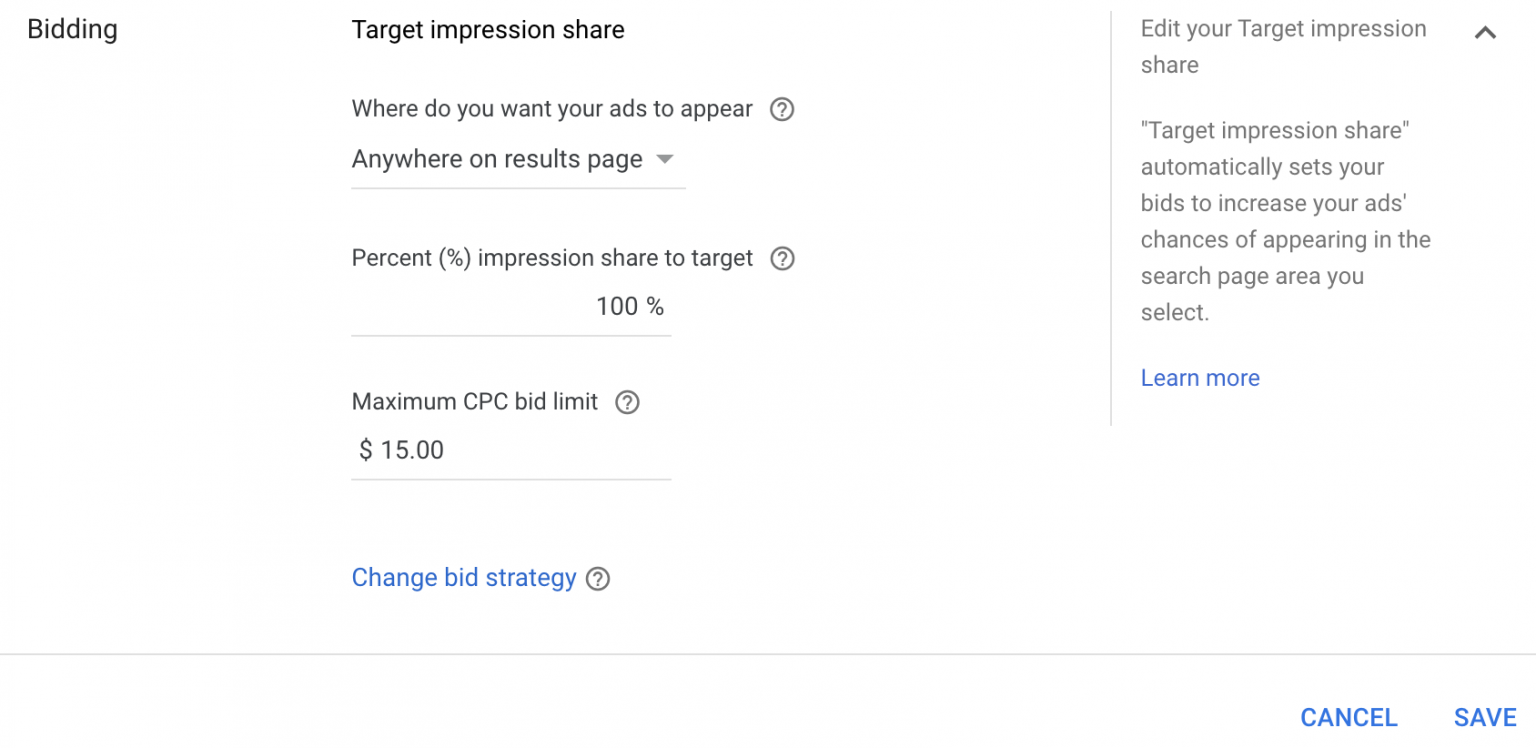
#Target impression share strategy manual#
Strategy 6: Manual CPC BiddingĪny marketer will tell you that there are pros and cons to manual CPC bidding. Be aware that this bidding strategy doesn’t look at the quality of the traffic, and it’s not the best strategy out there for driving conversions. You get to set the maximum CPC limit to keep your budget in line. This strategy is based on your maximum daily budget and Google will work to drive as many clicks as possible to your site. It’s also a good smart bidding strategy if you have a limited search volume for keywords or a limited budget. If one of your goals is to drive a large volume of traffic to your site, maximize clicks is a good Google Ads bid strategy to try. For that to work, you need to create different Google Ads conversions of varying values or you’ll need dynamic conversion events where you can follow the total value of a sale. One of the nice things about ECPC is that you can set bids based on a flat number of conversions or optimize for the value of conversions. If your CPC rate starts to climb too high, Google may lower your bid to decrease your costs for low-converting ads, and they’ll try to average it out at the maximum CPC settings. Google will adjust them based on the likelihood of a conversion. Also, you won’t need large amounts of data to get it going which makes it a viable strategy regardless of your ad budget.Īll you have to do is set the CPC for your ad groups and keywords. The main benefit of enhanced cost per click is that you get the ease of automated Ads bidding without having to give all the control to Google. Strategy 4: Enhanced Cost Per Click (ECPC) For best results, you want to have some conversion history, even if it’s minimal. The best CPC strategy for maximizing conversions is to set a reasonable daily budget amount, check your ROI at the end of the campaign, and determine whether the strategy increased your profit margin. Google won’t factor in any individual keywords set by advertisers, and your bids will be based on goal outcomes.

You simply set your maximum daily budget and Google will be off and running, bidding on your behalf with the goal of getting as many conversions as possible from your daily budget limit. One of the most straightforward Google Ads bidding strategies is maximizing conversions - a bidding strategy that’s fully automated. Here’s another tip - you’ll need a greater number of conversions (around 50 within the last month) than for target CPA, and you’ll also need to track revenue or value for your conversions to know how well it’s working. Just know that it could have a negative effect on the decision-making algorithms. You have the ability to set minimum and maximum bid limits at the campaign or portfolio levels which can help keep your budget in check. The bidding adjusts in real-time to get the best conversion rate and reach the goals you set at ad group, campaign, or portfolio levels.Īgain, the individual ROAS will vary per conversion, but Google will try to balance it out in the end.

The main difference with this bid strategy is that Google’s algorithms will use your history to make predictions about future conversion and conversion value performance. Target return on ad spend (ROAS) works along the same lines as target cost per acquisition. Strategy 2: Target Return on Ad Spend (ROAS) Google likes to see at least 30 conversions over the course of a month before you get started. Bear in mind, you’ll need a bit of history on your campaigns for them to perform well. You can set your target CPA at either the campaign or portfolio level and let Google adjust the keyword level bids accordingly.Īdvertisers will set caps to make sure Google doesn’t adjust too high or too low, and that’s the kind of flexibility you don’t get with individual campaigns. The CPAs may end up being slightly above or below your target CPA, but don’t worry, the numbers usually balance out in the long run. Google’s algorithm sets your bids according to your parameters to produce as many conversions as possible. With this Google Ads bid strategy, you set the amount you want to spend for a single conversion. Let’s begin with target cost-per-acquisition (CPA), which is a valuable strategy for optimizing conversions. Strategy 1: Target Cost Per Acquisition (CPA)


 0 kommentar(er)
0 kommentar(er)
